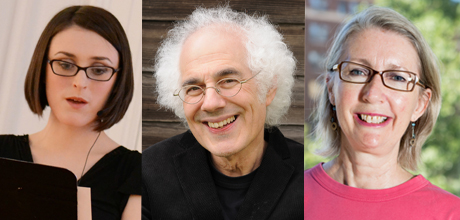As part of the George Washington University’s Arts Initiative, three faculty members from the Columbian College of Arts and Sciences were selected as incubator studio fellows, and three artists were invited to campus as visiting GW artists and scholars in residence.
Both programs are in their second year since launching through the university-wide Arts Initiative. Incubator studio fellows are faculty members chosen from all GW departments to receive a stipend and/or a teaching release to focus on creative research. The artists and scholars in residence are selected from all over the local community to produce work during a 10-month stay at the university. They receive studio space, research funds, a stipend and the opportunity to hire GW students through federal work study programs.
The incubator studio fellows include Dana Tai Soon Burgess, associate professor and chair of the Department of Theatre and Dance; Eugene Montague, assistant professor in the Department of Music; and Siobhan Rigg, an associate professor in the Department of Fine Arts and Art History. This year’s artists and scholars in residence are Beverly Ress, Sarah O’Halloran and Stephen Wade.
“Many of us on the Arts Initiative Committee have realized that one of the barriers in sharing our research with colleagues in other disciplines is, quite simply, the lack of time and resources. Both programs serve as the flagship components of the GW Arts Initiative by fostering an interdisciplinary approach to creative research and scholarship,” said Dean Kessmann, an Arts Initiative Committee member and associate professor in the Department of Fine Arts and Art History.
Mr. Burgess will use his time as an incubator studio fellow to work on the National Portrait Gallery’s “Dancing the Dream,” the Smithsonian’s first-ever exhibit on American dance. He will create two dances based on the exhibit, which will be presented later at the Kennedy Center. He said his goal is to “bring national attention to the performing arts at GW and exemplify how GW is at the core of an arts dialogue.”
“I believe that our diverse approaches to creativity speak to the breadth and depth of the arts offerings at GW,” Mr. Burgess said.
Dr. Montague will conduct research investigating how agency, or control over one’s action, plays into musical performances.
“I'm particularly looking forward to playing my part in furthering the blending of creative activities with academic pursuits, a mixture which is integral to our mission at GW,” Dr. Montague said.
To maximize its impact, the Artists and Scholars in Residence program expanded to three scholars this year, following the success of last year’s first resident artist Patrick Killoran. The Arts Initiative Steering Group worked to find the three artists by setting up an application process, getting the word out across the community and identifying five full-time faculty members to serve on the selection committee to make final decisions.
The selection committee sifted through applications from performing artists in the Washington, D.C., area before choosing Ms. O’Halloran, an Irish composer whose work includes concert pieces, videos, installations and more; Ms. Ress, a fine artist who uses colored pencil still life drawings to explore scientific concepts; and Mr. Wade, a Grammy-nominated folk artist whose travels through the U.S. have informed his work.
Ms. Ress, who will be working on an art series for the National Museum of Health and Medicine and an experimental piece in which bugs will eat through one of her drawings, said she looks forward to the connections the program will foster.
“Washington's arts community has been described as a vast network of underground mycelia, whose individual parts don't always know they are connected. GW's idea to bring artists onto campus is a way to make some of those community connections and to increase a sense of vibrancy for both the city and the university,” she said.
Even after just one year, Mr. Kessmann added, both programs have succeeded in creating cross-disciplinary interactions at GW.
“We are confident that these programs will continue to result in new and exciting creative research being done on campus by faculty members, students and visiting artists and scholars,” Mr. Kessmann said.


